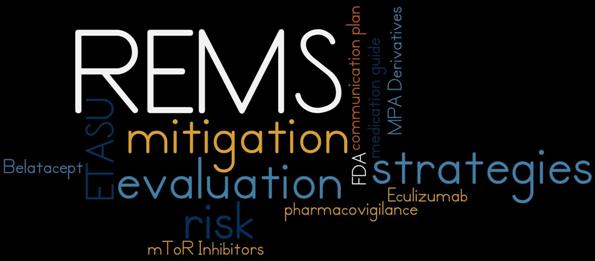REMS Resource Center

Welcome to AST's resource center for Risk Evaluation and Mitigation Strategies, or REMS. Review the general information on this page and then browse the sections below for more detailed information.
MEDICATION-SPECIFIC REMS INFORMATION
LISTEN TO THREE 15 MIN PODCASTS ON REMS
Risk evaluation and mitigation strategies (REMS) describes a process to manage known or potential serious risks associated with medications, and to ensure ongoing pharmacovigilance throughout the lifecycle of a drug. REMS may be a requirement for new drug approvals or may be implemented during the post-approval period based on the emergence of new safety concerns. Both brand name and generic products are subject to implementation and adherence to REMS programs.
If the FDA mandates that a pharmaceutical product requires REMS, certain steps must be implemented in order to mitigate the identified risks. Based on the severity of risk, REMS may include any or all of the following elements:
| Element | When Required | Description and Examples |
| Medication Guide | 1. Improved distribution of medication-specific information can help prevent severe adverse events. 2. Adherence to the drug therapy is critical to the efficacy of the medication. 3. Risks of adverse events are serious enough that the patient should be made aware of them before initiation of the therapy. |
Must be distributed to all patients receiving the medication at all times including the initial prescription fill and refills. |
| Communication Plan | 1. Improved distribution of medication-specific information can help prevent severe adverse events. 2. Risks of adverse events are serious enough that the patient should be made aware of them before initiation of the therapy. |
Examples include: “Dear Healthcare Provider” letter; continuing medical education; or communication with medical and/or professional societies. |
| Elements to Assure Safe Use (ETASU) | 1. Mitigate specific serious risks that would result in the drug not being approved or withdrawn from the market without these restrictions in place. 2. Medications initially approved without an ETASU for which the other elements of REMS described above are not deemed sufficient enough to mitigate these risks. |
Controlled system including restrictions on prescribing and distribution. Examples include: patient registries or limitation of medication distribution via certified healthcare professionals and/or pharmacies. |
REMS resource center content provided by Steven Gabardi, PharmD of Brigham and Women's and reviewed by Rita Alloway, PharmD, Diane Cibrik, MD, and Richard Formica, MD. This resource center was made possible in part by support from Bristol-Myers Squibb Company.
Donate
Donate
Career Center
Career Center
Patient Education
Patient Education
Educational Content Disclaimer: The content, information, opinions, and viewpoints contained in educational materials housed on and linked from the AST web site are those of the authors or contributors of such materials. While the AST and its committees take great care to screen the credentials of the contributors and make every attempt to review the contents, AST MAKES NO WARRANTY, EXPRESSED OR IMPLIED, as to the completeness or accuracy of the content contained in the educational materials or on this website. The reader of these materials uses these materials at his or her own risk, and AST shall not be responsible for any errors, omissions, or inaccuracies in these materials, whether arising through negligence, oversight, or otherwise. Reliance on any information appearing on this site is strictly at your own risk. Read the full disclaimer.
